Ash bushes are a beautiful addition to any panorama, imparting color and natural beauty to your yard. However, with the rise of invasive pests and diseases, defensive these timber has emerge as extra critical than ever. In current years, ash bushes have been plagued by means of a variety of diseases that may quickly kill the tree if left untreated. As a accountable homeowner or landscaper, it’s vital to know a way to become aware of those sicknesses so that you can take the important steps to defend your trees. In this manual, we will talk seven of the maximum common illnesses that affect ash trees, how to perceive them, and the quality strategies for remedy and prevention. With this understanding, you may make certain that your ash bushes stay healthful and vibrant for future years.
Ash bushes are a valuable and cherished a part of our herbal surroundings. With their sleek branches and vibrant green leaves, these timber provide shade, splendor, and habitat for numerous natural world. However, in latest years, ash bushes were underneath risk from diverse sicknesses that can speedy devastate complete populations.
The importance of shielding ash trees can not be overstated. Not most effective do these trees play a crucial function inside the atmosphere, however they also keep cultural and historic significance in lots of areas. Ash wooden is noticeably valued for its energy and versatility, used in the entirety from furniture to musical contraptions. Additionally, ash bushes make contributions to air satisfactory by absorbing pollutants and freeing oxygen, making them vital for maintaining a wholesome surroundings.
Unfortunately, ash bushes are in particular liable to several diseases, including the notorious emerald ash borer, ash yellows, and ash dieback. These diseases can weaken the timber, main to branch dieback, crown thinning, and sooner or later death. Without right identity and remedy, entire ash tree populations may be worn out, ensuing in extensive ecological and economic losses.
In this comprehensive guide, we purpose to equip you with the information and equipment to discover and deal with the seven maximum not unusual diseases affecting ash timber. By expertise the symptoms and symptoms of these illnesses and implementing suitable preventive measures and remedy alternatives, you could assist protect your ash bushes and maintain their splendor and ecological significance for generations to come back.

Ash Tree Diseases
1. Ash Anthracnose Illness
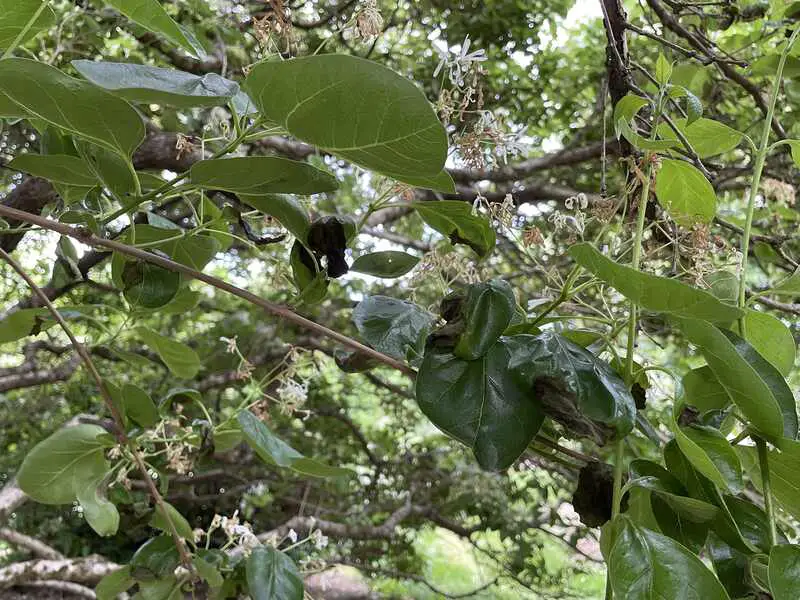

Bushes affected: Ash anthracnose illness is very frequent in inexperienced ash. Anthracnose is restricted to the form of tree it infects, so anthracnose of oak is not going to have an effect on ash (Fraxinus spp.), and anthracnose of ash is not going to unfold to every other kind of tree in addition to ash. Nonetheless, the signs and the administration strategies are the identical for many anthracnose illnesses of bushes.
Signs:
- Leaves might develop giant black or tan patches that trigger the leaves to deform in these areas.
- Small purple-to-brown spots may seem in the course of the leaves.
- In extreme instances, full defoliation might happen.
- Signs usually first happen on the decrease and inside cover leaves.
Causes: The fungus that causes ash anthracnose, Gnomoniella fraxini, overwinters within the higher elements of bushes in seed samara or on twig cankers. Spores kind in tiny fruiting our bodies and start an infection across the time the ash leaves are budding out. Spores are unfold by wind and splashing rains to infect buds, twigs, and newly rising leaves.
Season: An infection happens within the spring and prefers moist, cool climate.
Remedy: Prune affected branches. In autumn, get rid of all fallen leaves to assist stop any extra spores from reinfecting within the spring. Iowa State University doesn’t suggest the usage of fungicides since anthracnose isn’t a extreme drawback in ash bushes.
Threat: Ash anthracnose illness isn’t a priority for wholesome mature bushes until it’s extreme for a lot of consecutive years. If the tree experiences a number of reinfections, it could weaken and change into susceptible to different illnesses and pests.
2. Ash Yellows


Bushes affected: White ash is especially vulnerable to ash yellows, also called ash decline. Ash yellows can also be a typical Arizona ash tree drawback.
Signs: Ash yellows illness impacts bushes of all ages, and the next signs normally happen inside three years of an infection:
- Leaves might seem smaller, thinner, and lighter inexperienced.
- Bushes will sometimes develop branches in tufts.
- Contaminated bushes might develop at a a lot slower fee than non-contaminated bushes, usually reaching about half the peak of a wholesome tree.
Causes: Ash decline is attributable to the phytoplasma Candidatus Phytoplasma fraxinii, a micro organism-like organism. The phytoplasmas stay and survive within the meals-conducting tissue of the contaminated plant. There is no such thing as a definitive reason for ash yellows, however leafhoppers could be the major means by which the phytoplasmas unfold from tree to tree.
Remedy: There is no such thing as a recognized remedy for this ash tree illness. Take away any infested bushes instantly to stop the unfold of phytoplasma to wholesome bushes. In accordance to the University of Wisconsin-Madison, wooden from contaminated bushes can be utilized as firewood or chipped for mulch.
Threat: Some contaminated bushes might stay and develop slowly with ash yellows for a few years. Contaminated bushes finally expertise department dieback, step by step main to tree loss of life.
3. Verticillium Wilt

Bushes affected: Verticillium wilt is a fungal illness that impacts over 300 species of crops.
Signs:
- Leaf edges flip yellow, then brown and dry.
- Sudden wilting on one or a number of branches might happen. It’s typically just one facet of the tree that wilts.
- The wooden beneath the bark of drooping branches typically has discolored streaks. Chances are you’ll discover the wooden’s discoloration after pruning.
Causes: Bushes underneath stress from drought, vitamins, or salt are extra doubtless to expertise Verticillium wilt. The soil-borne fungus Verticillium albo-atrum causes Verticillium wilt.
An infection happens within the root system, the place the fungus produces resting buildings that may survive within the soil for a few years. The fungi that develop from these buildings might penetrate the roots and trigger water motion inside the tree to endure.
Season: Signs happen in midsummer.
Remedy: For the reason that fungus can stay for a very long time underground, it’s greatest to plant resistant bushes within the contaminated soil. To delay the development of Verticillium wilt, prune affected limbs and present your tree with enough water and fertilizer.
Threat: Verticillium wilt might kill your ash tree in a single season. Your ash tree may survive for a lot of seasons, with every department slowly dying.
4. Ash Rust
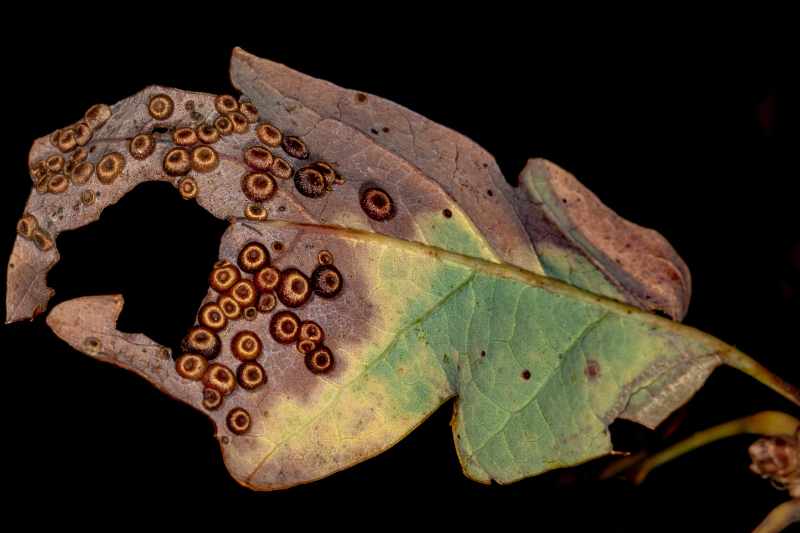

Bushes affected: Vulnerable ash bushes embrace white, inexperienced, and black ash.
Signs:
- Small yellow or yellow-orange spots seem on the higher leaf surfaces.
- About 10 days later, brilliant orange-yellow clusters of spore-producing buildings (aecia) develop beneath the leaf.
- Leaves might change into distorted.
Twigs and stalks becoming a member of the leaf and stem (petioles) might develop wart-like swellings. These swellings can even kind the clusters of aecia. Leaf tissue will start to die, and some bushes might seem scorched. Closely contaminated bushes might expertise defoliation.
Trigger: The ash rust fungus (Puccinia fraxinata) has 5 spore levels, two of which happen on an alternate host (marsh and wire grasses). Within the spring, teliospores infect the tissues of ash, which then develop spermogonia and aecia. The aecia produce aeciospores, which the wind then blows to both alternate hosts.
Uredinia then kind on the brand new hosts in early summer season and produce urediniospores, which repeatedly infect wire and marsh grass. The uredinia will become brownish-black telia buildings that produce teliospores. These teliospores then infect the ash bushes the next spring.
Season: Signs might first seem in mid-Could.
Remedy: The University of Delaware recommends making use of Systhane WSP (myclobutanil) or Immunox. Fungicides might solely act as a preventative measure and is not going to be an efficient management methodology as soon as your ash tree has been contaminated.
The Cooperative Extension suggests making use of the fungicide two or thrice across the time leaves begin to increase. Then a few times once more at 10-day or two-week intervals.
Threat: Ash rust not often kills bushes.
5. Powdery Mildew
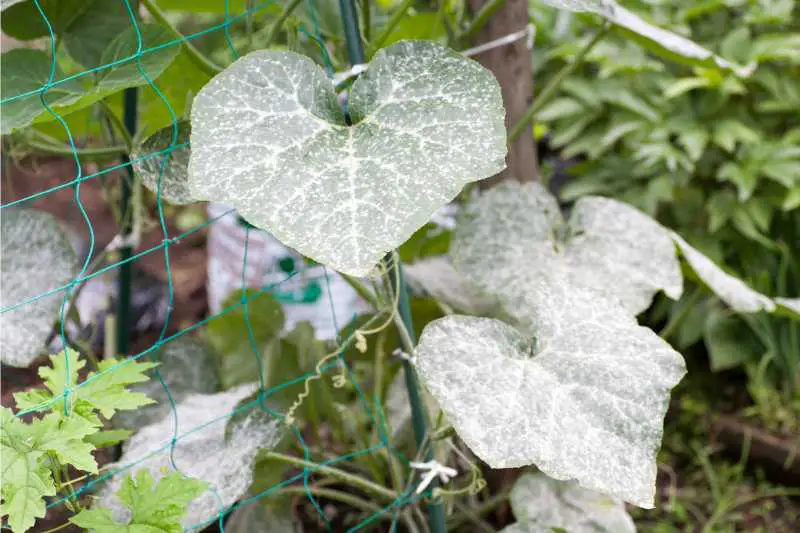

Picture Credit score: Miyuki-3 / Canva Professional / License
Bushes affected: Powdery mildew can have an effect on many bushes. The most typical embrace ash, lilac maple, dogwood, magnolia, basswood, crabapple, catalpa, and oak.
Signs:
- The fungi produce microscopic chains of spores that give the contaminated areas a white powdery look (higher and decrease leaf surfaces, younger stems, shoot ideas, blossoms, and flower buds).
- The An infection might trigger leaf yellowing, browning, distortion, or untimely leaf drop.
Trigger: A carefully associated group of fungi causes powdery mildew. The powdery mildew fungi overwinters inside contaminated buds. When the buds open in spring, they change into coated with powdery spores, which the wind then carries to infect new leaves, fruit, and shoots.
Remedy: Plant vulnerable bushes in areas with enough daylight and good air circulation to cut back moisture. Chances are you’ll prune your crops to guarantee air circulation. You possibly can deal with powdery mildew with a registered fungicide, which can additionally assist to management the illness.
Threat: Powdery mildew isn’t deadly. Younger ash bushes rising in closely shaded areas are essentially the most affected by this illness.
Notice: Powdery mildew may have an effect on your garden. You possibly can deal with powdery mildew in your garden with garden fungicides and stop the situation with cultural practices reminiscent of reseeding shady spots, watering correctly, and mowing on the correct peak.
6. Cotton Root Rot
Bushes affected: This fungal illness is also called Phymatotrichum root rot, Texas root rot, and Ozonium root rot. The illness infects greater than 2,000 species of crops and is without doubt one of the most difficult fungal illnesses to management.
Signs:
- Signs start with a slight yellowing or bronzing of the host’s leaves.
- After three days, everlasting wilting happens, adopted by loss of life.
- Bushes and shrubs succumb to the illness extra slowly.
- Affected areas seem as round patterns of useless crops and can step by step enlarge over time.
Causes: Cotton root rot is attributable to the fungus Phymatotrichopsis omnivorum. The fungus invades new areas by gradual development via the soil from plant to plant. The fungus can survive within the soil for a few years and so far as 8 toes deep within the floor.
Remedy: Cotton root rot is without doubt one of the most tough plant illnesses to management. One answer is to plant a resistant grass crop across the contaminated space. The resistant crop creates a barrier that limits the unfold of the illness.
If cotton root rot is infecting your ash tree, there’s a probability of saving the tree if the decay will not be but substantial. Oklahoma State University recommends protecting a ridge of soil across the tree’s drip line with a 2-inch layer of natural matter or cow manure. Then, scatter ammonium sulfate and sulfur over the manure.
Flood the basin with sufficient water to soak the soil to a depth of three toes. Hold the soil moist for a number of weeks after remedy. Your ash tree is probably going to get better inside the season.
Seasons: Signs normally happen from June via September when soil temperatures attain 82 levels.
Threat Stage: This fungal illness can survive within the soil for a few years and kill even your largest ash tree.
7. Mycosphaerella Leaf Spot


Bushes affected: No resistant ash species are recognized. Species differ of their degree of susceptibility.
Signs: Two species of Mycosphaerella (M. effigurata and M. fraxinicola) trigger Mycosphaerella leaf spot. Each species have distinctive indicators, however they might be current on the similar time.
- M. fraxinicola kinds giant, irregular leaf spots (5- to 15-mm) that go from mild inexperienced to brown with yellow surrounding them.
- M. effigurata kinds many small, yellow to brown spots (1- to 3-mm).
- The illness begins on the bottom a part of the ash tree and step by step strikes up.
- Bushes with extreme an infection might have untimely defoliation.
Trigger: This illness is triggered by moist situations. Lots of white spores (conidia) kind on the higher leaf floor. In late fall, stromata develop in lesions beneath the leaf and produce spores. Ascospores overwinter in leaf litter and then provoke an infection in late spring to early summer season.
Remedy: In accordance to the U.S. Division of Agriculture, there are not any chemical management measures for controlling this illness. To assist stop Mycosphaerella leaf spot, raking leaf litter might assist cut back the overwintering illness. Prune your ash tree correctly to promote good airflow, and water your tree repeatedly to preserve its well being.
Threat: This illness will normally not hurt your ash tree. Nonetheless, repeated an infection and defoliation might consequence ill.
Ash Tree Pests
1. Emerald Ash Borer


Bushes affected: All ash bushes are vulnerable to emerald ash borer.
Signs:
- Harm normally turns into seen 2-5 years after the emerald ash borer (EAB) has infested your tree.
- Cracks within the highest branches are usually the primary signal of harm. Cover dieback normally follows.
- Because the larvae make their tunnels, they start to girdle and kill branches and the trunk.
- Bushes might develop new shoots on the trunk referred to as epicormic branching.
Causes: The emerald ash borer is an invasive wooden-boring beetle native to Asia. This pest was first discovered within the U.S. in 2002 close to Detroit. The EAB has since unfold to a number of states and has killed tens of millions of ash bushes.
Season: The grownup beetles begin to emerge in Could and early June. Beetle exercise peaks between mid-June and early July.
Remedy: Infested bushes want to be eliminated and destroyed as quickly as potential. If emerald ash borer has infested bushes in your county or metropolis, the Virginia Cooperative Extension recommends making use of a systemic insecticide as a drench to the bottom of the tree in Could or early June.
Threat: Infested ash bushes not often get better and usually die quickly after signs seem.
2. Banded Ash Borer
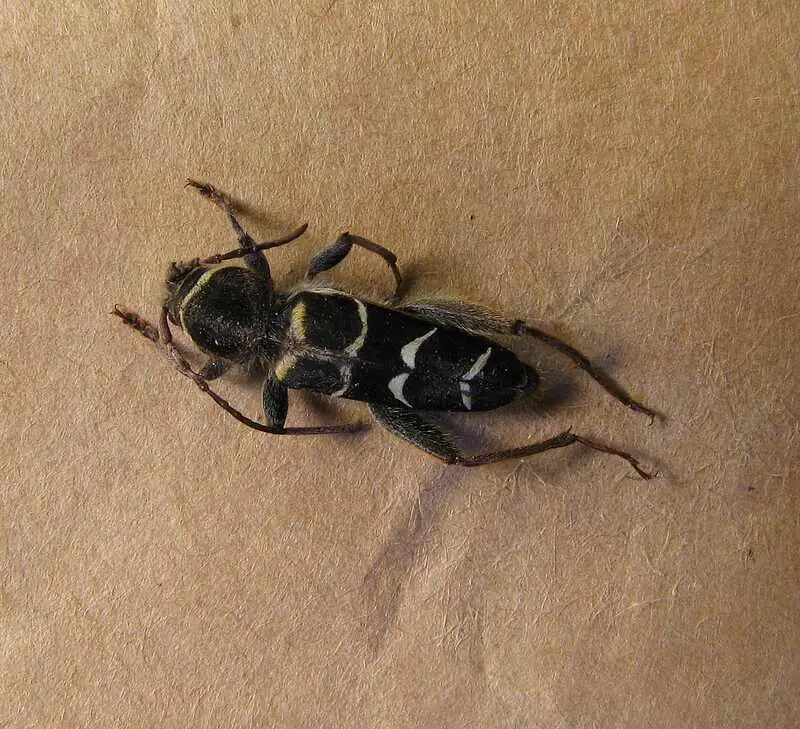

Bushes affected: Ash, hickory, elm, mesquite, and white oak are the commonest hosts of the banded ash borer.
Signs:
- Tunneling larvae of the banded ash borer might weaken a tree’s limbs, making them vulnerable to breaking in sturdy winds.
- Infestation signs of the banded ash borer will be confused with the emerald ash borer. The banded ash borer’s tunnels have a tendency to curve and zigzag with no path, extending deep into the tree. The emerald ash borer, however, has S-formed tunnels which might be made straight underneath the bark of the tree.
- The exit holes of the banded ash borer are spherical, whereas the emerald ash borer produces D-formed exit holes.
Causes: Not like the emerald ash borer, the banded ash borer prefers to assault useless, dying, diseased, or careworn bushes somewhat than wholesome bushes. Within the spring, adults deposit eggs within the crevices of the host tree’s bark.
The larvae feed underneath the bark earlier than boring into the sapwood, the place they feed till the tip of summer season. Within the fall, the larvae pupate and emerge as adults the next spring.
Remedy: Earlier than infestation happens, the Virginia Cooperative Extension recommends making use of the systemic pesticides dinotefuran and imidacloprid as a soil drench. These pesticides might assist kill the grownup females chewing on the bark to lay their eggs and newly hatched larvae boring into the sapwood.
Chances are you’ll discover grownup banded ash borers in your house after rising from firewood introduced inside. As an alternative of treating the firewood with pesticides, go away the firewood outdoors your own home till you need to burn it.
Threat: As a result of banded ash borers want useless or dying bushes, your tree might already be in danger due to one other illness or stress situation.
3. Ash Flower Gall
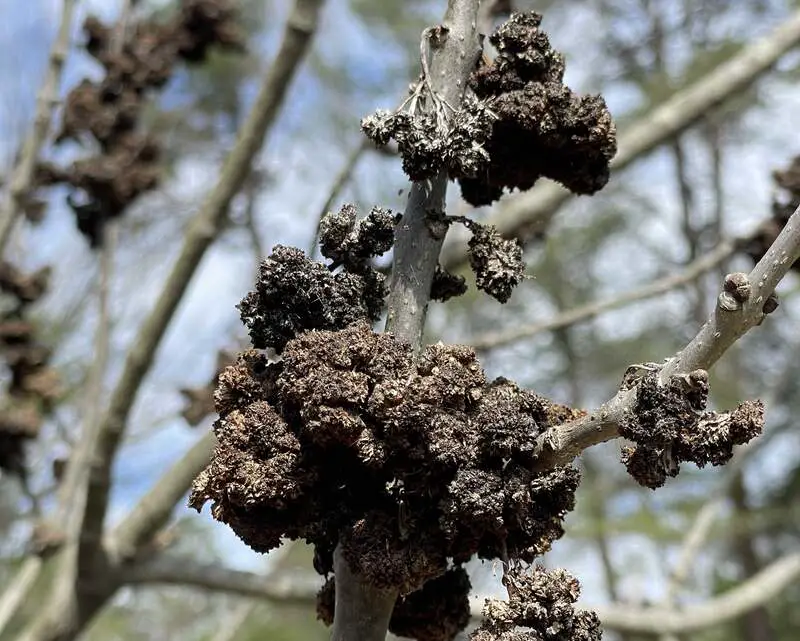

Bushes affected: Ash flower gall impacts most male ash bushes.
Signs:
- Male flowers develop spherical, greenish, one-half to 1-inch diameter tumor-like buildings referred to as galls.
- These irregular plant buildings flip darkish brown and woody in late summer season and might trigger leaf distortions.
Trigger: An eriophyid mite causes the flowers to kind the galls.
Season: These worm-formed mites, invisible to the bare eye, spend the winter underneath the buds and start gall development in early spring.
Remedy: As soon as galls begin rising on the tree, remedy could also be too late. So what are you able to do? Eliminate the mites earlier than the galls have the prospect to develop. The University of Wisconsin-Madison recommends an software of carbaryl (Sevin) within the spring when the primary blossoms start to kind to assist cut back the variety of galls.
Threat: Ash flower gall is not going to hurt your ash tree, however it can have an effect on its look. If the load of the gall tissue is simply too heavy, the galls might pressure the branches.
Preventive measures: How to shield ash bushes from illnesses
Preventive measures are crucial in defensive ash timber from illnesses. As the saying is going, prevention is higher than remedy, and this holds authentic inside the case of retaining the health and energy of ash trees. By enforcing the following measures, you can significantly reduce the hazard of illnesses and ensure the longevity of the one you love bushes.
- 1. Regular Inspection: Conduct habitual inspections of your ash bushes to identify any signs of sickness development. Look for symptoms like leaf discoloration, wilting, cankers, or uncommon boom patterns. Early detection is fundamental to preventing the unfold of sicknesses.
- 2. Pruning and Trimming: Practice right pruning techniques to eliminate dead, inflamed, or weakened branches. This helps enhance airflow and sunlight penetration, decreasing the possibilities of fungal infections and infestations.
- 3. Sanitation: Maintain cleanliness round your ash bushes via getting rid of fallen leaves, twigs, and debris. These can harbor disease-causing pathogens and bugs, which could easily infect healthy trees.
- Four. Proper Watering: Ensure your ash trees obtain ok water, especially in the course of dry durations. However, avoid overwatering as it may create an surroundings favorable for fungal increase.
- Five. Mulching: Apply a layer of natural mulch around the base of your ash trees. Mulch helps retain moisture, modify soil temperature, and suppress weed increase. Make positive to maintain the mulch faraway from the trunk to save you rot and pest infestation.
- 6. Fertilization: Provide balanced fertilization to beautify the overall health and energy of ash bushes. Consult an arborist or tree care professional to determine the best fertilizer and alertness approach in your precise tree species.
- 7. Tree Diversity: Promote biodiversity on your panorama by means of planting numerous tree species along your ash trees. This reduces the risk of sicknesses affecting a couple of timber in your place, as different tree species regularly have one-of-a-kind susceptibility stages.
Best practices for tree care: Maintaining the fitness of ash trees
Maintaining the health of your ash bushes is essential in protective them in opposition to commonplace illnesses. By following satisfactory practices for tree care, you could make certain that your ash bushes thrive and stay robust for years yet to come.
- 1. Regular Inspections: Conduct normal inspections of your ash timber to identify any signs and symptoms of sickness or infestation. Look for symptoms such as thinning foliage, dead branches, or discolored leaves. Early detection can assist save you the spread of diseases.
- 2. Proper Pruning: Pruning is an critical a part of tree care, because it allows put off lifeless or diseased branches, improves air movement, and promotes healthy growth. Make positive to apply right pruning techniques and equipment to keep away from causing similarly damage to the timber.
- 3. Adequate Watering: Providing enough water for your ash timber is important for their normal fitness. Water deeply and carefully, particularly in the course of dry durations, to ensure that the roots get hold of proper hydration.
- 4. Mulching: Applying a layer of natural mulch across the base of your ash timber can help keep moisture, alter soil temperature, and prevent weed growth. However, be careful no longer to pile mulch in opposition to the trunk as it could result in moisture retention and capacity rot.
- 5. Fertilization: Consider fertilizing your ash bushes to provide them with vital nutrients. Consult a professional arborist or horticulturist to determine the right kind and quantity of fertilizer in your specific tree species and soil conditions.
- 6. Soil Management: Maintaining nicely-drained soil is critical for the fitness of your ash bushes. Avoid overwatering or permitting the soil to turn out to be compacted, as those situations can lead to root rot and other illnesses. Regularly aerate the soil to enhance its great.
- 7. Pest Control: Keep an eye fixed out for not unusual pests that can infest ash timber, inclusive of the emerald ash borer. Implement preventive measures, which include the use of insecticidal sprays or attracting beneficial insects, to defend your bushes from harmful pests.
FAQ About Ash Tree Diseases
What’s the Most important Reason behind Ash Tree Dying in North America?
The emerald ash borer (EAB) is the principle reason for ash tree loss of life in North America, attacking all 16 ash tree species.
What’s the Distinction Between Ash Yellows and Emerald Ash Borer?
Ash bushes contaminated with ash yellows can current signs comparable to these of an emerald ash borer infestation (department dieback, cankers and vertical cracks close to the bottom of the tree, growth of suckers, and clumped sprouts). To distinguish the 2, listen to these indicators:
- D-formed exit holes and S-formed galleries underneath the tree bark are inform-story indicators of the emerald ash borer (EAB). An lively infestation may also be indicated, curiously sufficient, by woodpecker harm. The birds can take away the bark when attempting to attain larvae.
- Alterations on the leaves (lighter colour, a smaller-than-regular dimension, and cupped margins) are among the many predominant indicators of ash yellows. Twig development can also be impaired, ensuing within the leaves focused on shorter lengths of twigs.
The stress attributable to the illness might appeal to different pests, so you may additionally discover exit holes within the wooden. Nonetheless, the form and dimension will likely be totally different from EAB’s D-formed exit holes.
Ought to I Reduce My Ash Tree Down?
In case your ash tree has misplaced greater than 30% of its cover, then it’s time to rent an expert to take away the tree safely.

